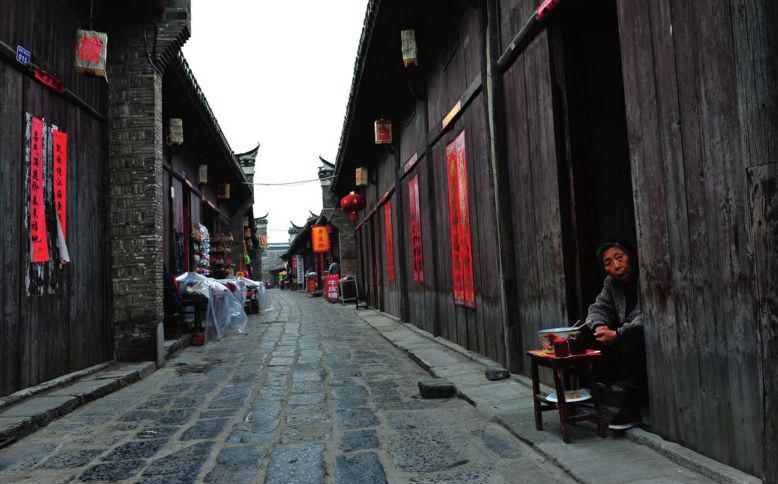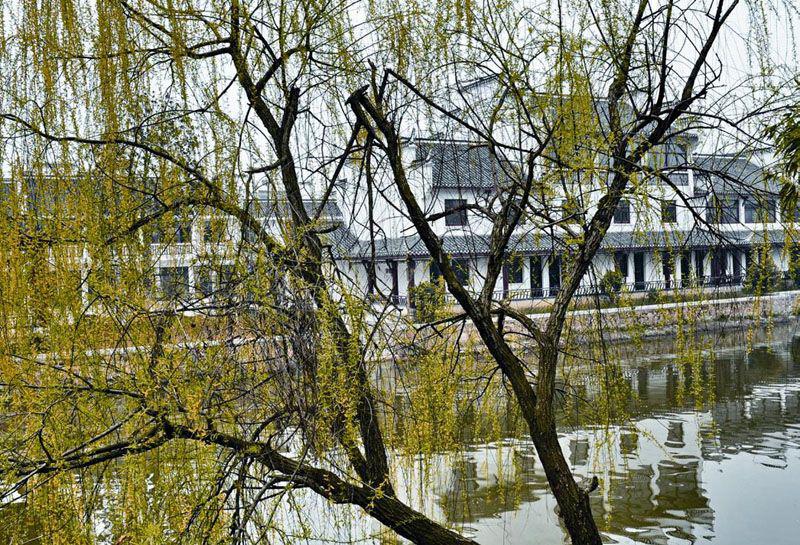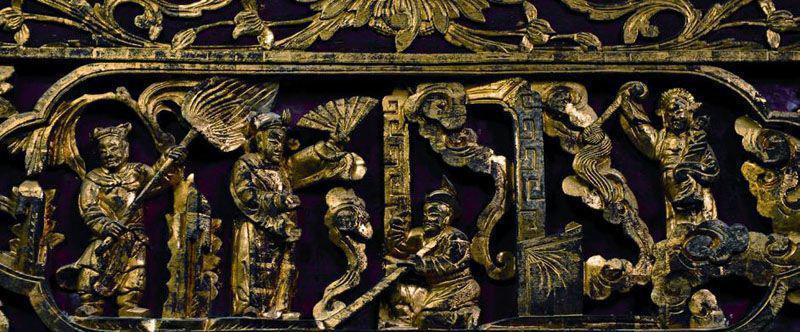Sanhe Town

AMONG the numerous old towns of China, the “big three” are Wuzhen in Zhejiang Province, Zhouzhuang in Jiangsu Province and Lijiang in Yunnan Province. These towns, while undoubtedly stunning, can be overrun with tourists during high season. Luckily, China boasts a swathe of lesser-known old towns, many of which are arguably just as breathtaking as the famous few and yet remain off the radar of most tourists. Sanhe Town in Feixi County, Anhui Province is just such a town.
Geography was an important factor in enabling Sanhe Town to flourish as a melting pot of professionals and traders. Geography is in the very name of the town: Sanhe means “three rivers,” referring to the Fengle, Hangbu and Xiaonan rivers that idle their way through the town.
Sanhe Town is about 40 kilometers south of provincial capital Hefei, sitting at the junction of three counties (Feixi, Shucheng and Lujiang) and three cities(Hefei, Chaohu and Luan). We set out from Hefei on a misty morning in early spring. As we arrived at the old town the gate tower rose out of the fog to greet us. Its safe to say we were mesmerized even before wed set foot onto the towns stonepaved alleyways.
Elegant Residences
Sanhe, established over 2,500 years ago, is the best-preserved riverside town in Anhui Province. It is a rich repository of late-Qing Dynasty history and boasts some of the nations best examples of ancient Hui-style architecture. Its meandering rivers, spectacular bridges, narrow alleys, elegant houses and ancient battlefields form a visage that resembles the famous painting Qingming Festival at the Riverside.
There are dozens of streets in Sanhe Town, most of which measure roughly three meters wide. The middle street paved with blue slabstones is called the“officials road.” It is flanked by walkways paved with crushed stone, called the“commoners road.”
Many years of traffic have polished the slabstone paths. They appear shiny and almost translucent after a mornings drizzle.
The streets are lined with stores built in the Ming and Qing architectural style. The grey-tiled roofs, the white horsehead walls (named so because the white walls and tiled roof resemble a white horse and its flying mane) and the black signboards featuring gold Chinese characters make it seem one has stepped back into times past.
Our guide told us that most of the towns residents have lived here for generations, and that the traditional layout of their houses – a shop in front and a workshop behind, has been maintained.
Nowadays, other than seniors who have rented out their houses for commercial use and moved closer to their children in big cities, most residents have stayed on in the town. They have incentive to remain as tourism is bringing in solid incomes, and visitor numbers look set to increase.
The horsehead wall is a prominent feature of Hui architecture – walls in staircase-style jutting out from the roof gables. Most old towns in Anhui were densely populated. If a fire broke out at one residence, neighboring buildings would soon be affected. One clever magistrate of Huizhou Prefecture in the Ming Dynasty had an idea: increase the height of the gable walls of every fifth to tenth house to cut off the source of fire and prevent it from spreading. For this reason, horsehead walls are also knows as fire-sealing walls.
The horse is considered an auspicious animal in traditional Chinese culture. As local Hui merchants traveled around the country and rose to commercial prominence, horsehead walls became endowed with more meanings: the higher a buildings walls, the higher the social status of its residents. Also, as local men would often leave their hometown for business as teenagers, the horsehead walls were a material symbol of the wish for a family reunion .
Gazing at the beautiful contrast of dark grey roofs and crisp white walls, we were deeply impressed by the craftsmanship and creativity of the Hui architects. Horsehead walls brought the houses to life. Seen from afar, the horsehead walls reminded us of the classic Chinese painting 10,000 Galloping Horses, a symbol of prosperity of China.
The exterior facades of Hui-style residences are delicate and their interior designs often luxurious. They have an open space in the center surrounded by houses or high walls. This design reflects the desire to amass wealth. Local residents considered raindrops as a symbol of fortune, and believed fortunes would“pour in” if they collected the years rainfall. They hence set up a system of pipelines that at every corner of their yards to gather rainwater, channeled outside through sewerage. Such a concept signifies the bygone mentality: “Keep the benefits within the family.”
After the morning drizzle ceased, residents opened their doors and sat in front of their houses. Some were stirring malt sugar, others making handicrafts, and still others enjoying the sunshine.
Passing by one house, we noticed a beautiful red lantern inscribed with the Chinese character Qiao. The owner of the house, an elderly gentleman, smiled and told us it was his family name.
The tradition of hanging a lantern with the male owners surname in front of gate has lasted for over 1,000 years in Sanhe Town. It is said that lanterns hung in front of doors, in addition to being decorations for festivals, also convey family news. For example, a red candle in the lantern means the family is holding wedding. A white candle signifies a funeral. A slip of white paper on the surname means the death of a male.
Strolling around town, we walked down a number of extremely narrow alleyways, one of which I didnt even notice at first glance. This was the “One Person Alley,” the oldest and most famous in the town. Two people walking side by side stand no chance of passing through here. We reached the end of it and arrived at the former residence of Chen Ning Yang, laureate of the Nobel Prize for Physics in 1957. In 2001 he came back to revisit his former residence in this alley.

sanhes Waterways
There are few riverside towns in central Anhui, and Sanhe Town is without a doubt the most beautiful among them. The Xiaonan River runs through the town from south to north to meet the Fengle and Hangbu rivers, which then flow on into Chaohu Lake. Since time immemorial the fate of Sanhe has been closely linked to its river system.
Roads and waterways were the major forms of transportation in ancient China, and the Xiaonan River was a heavily used route. This made Sanhe Town the most important commodity collection and distribution center in the region between the western bank of Chaohu Lake and the eastern edge of the Dabie Mountains. Everyday goods such as aquatic products, ceramics, rice, silk, bamboo and timber were transported from the upper reaches of the river to Sanhe Town. They were then sold on to towns of the rivers lower reaches. Daily use articles from Nanjing and Shanghai were also transported here for distribution in the region. At that time many merchants converged in Sanhe Town. Ships formed steady traffic through the town, making it the “commodity corridor” of central Anhui.
In the Tang (618-907) and Song (960-1279) dynasties, locals developed the former flood plain around the town into croplands that extended several kilometers. It was after this cultivation that the town became known as a commercial port that shipped out large volumes of rice.
A rice granary from those times is still in good condition today. Its grand size featuring multiple courtyards is testament to the prosperity of the town in former times.
Owing to its location at the crux of three rivers, Sanhe has traditionally been a place of great strategic importance. To the towns north lies Chaohu Lake and Hefei City, formerly known as Luzhou. The way to important towns further south, such as Anqing and Jiujiang, also passed through Sanhe, not far from Nanjing, a historic capital of China.
Sanhe has witnessed epic battles. It was here that in 1858, the eighth year of the reign of the Qing Dynasty Emperor Xianfeng, commanders of the Taiping Rebellion, namely Chen Yucheng, Li Xiucheng and Wu Dinggui, defeated the army led by Qing commander Li Xubin. The battle was a major engagement of the Taiping Rebellion, bringing instant national fame to the town.
Standing atop the ancient city wall and surveying a commanders post and rusted barbettes, formidable warriors fill my imagination. I seem to hear the sound of blasting cannons. But the days of battle in Sanhe are long gone. Todays Sanhe is a tranquil riverside town, albeit with some bloody history.
The breeze soothes my skin as we descend to the Xiaonan River. Ten bridges straddle it, many of which are renowned as engineering feats. Of the 10, our guide says, Sanxian Bridge is the best known and Quezhu Covered Bridge the oldest. Fish dart close to the rivers surface, drooping willows sway gently in the breeze, slow boats meander along the bank and life on the river is a charming and beautiful sight to behold.

Food, Glorious Food
We stopped by a food stall to sample the local specialty – Sanhe Mijiao (dumplings in wrappers made from rice flour). In northern China, jiaozi wrappers are made from wheat flour, but in Sanhe they use rice flour. These dumplings are stuffed with minced meat and beancurd. The difference sounds trivial, but it makes a big difference to the taste. The deepfried dumplings are crispy and delicious.
Near the mijiao stall was a grocery store selling locally made rice wine and dried beancurd. The owner told us that the production of dried beancurd in Sanhe has a history of over 1,000 years, and that their beancurd was especially tasty due to the outstanding quality of the local water.
In front of the store, we spied locals drying small river fish in the sun. Such dried fish count as Anhuis favorite complement to rice in the winter months.
The culinary culture of Sanhe Town has a long and interesting history. Owing to frequent north-south traffic along the Xiaonan River, many visitors spent time in the town and left their culinary mark. Local cuisine thus developed its distinctive style that combines the best of Anhui, Sichuan and Jiangsu dishes. A well-known folk song in Sanhe mentions a number of local gastronomic favorites, such as melon seeds, Yudai cake, shrimp-flavored dried beancurd and fried Shaomai – a kind of steamed dumpling.
In October 2008, Shu Ting, a renowned Chinese poetess, visited Sanhe Town and fell in love with the local food. She expressed her feelings for the town in a subsequent travel piece, in which she also admitted to gaining much poetic inspiration from its delicately prepared specialties. She singled out Sanhes glutinous rice wine, shredded whitebait and soy sauce-stewed duck as favorites.
Walking down ancient slabstone pathways, breathing air redolent of nearby rivers and sampling delicious local food, I found myself falling deeply in love with this peaceful and simple town. It was hard to leave.
travel tips:
Getting to and from the town is convenient. Buses leave from Hefeis South Gate Bus Station throughout the day. From Sanhe bus station to the town is a two-minute walk; theres no need to deal with taxi drivers.
The tourism season in the town starts in early spring, and visitor numbers peak during the Dragonboat Festival in June.
The town hasnt changed much over the years, but so far a comprehensive map is yet to be produced. The best way to see it is to explore it yourself. Some areas require tickets for entry, but the “One Person Alley,” “Ancient City Wall” and “Town Gods Temple” are all free. The town is not big, so one day is plenty to take in the sights. Local dishes made from local ingredients are must-try. Let the natural flavors win you over – very little seasonings or spices are used here. There is also a wide variety of freshly made local delicacies sold in packages around the town. These make great gifts for those not lucky enough to visit the town in person.

West Lake Fish in Piquant Sauce
West Lake fish in piquant sauce is a dish that originates in ancient China in a touching story about two brothers named Song.
The brothers loved to fish, and were good at it. One day the elder brother married a beautiful woman. A local villain, however, jealous of Songs wife, wanted her for himself and murdered the elder Song. The younger brother and his sisterin-law were filled with indignation and filed a lawsuit against the villain. But the local officials were in league with the villain and drove them out.
Since their safety was under threat, the widow urged the younger brother to flee, and for their parting meal she cooked him a bowl of fish. Upon tasting the dish, the younger brother was confused at the unusual flavor of sugar and vinegar, and asked her why she had combined them. The widow explained that the sweetness of the sugar represented her hope that he lead a sweet life, and the acidity of the vinegar that he never forget the pain of being oppressed.
Several years later, the younger brother passed the imperial examination and was appointed governor of Hangzhou. He punished the villain and searched for his sister-in-law, but could find no trace of her.
Then one day at a feast a friend had held in his honor, he tasted a dish that reminded him of thathis sisterin-law had cooked for him all those years ago. He immediately demanded to know where it had come from. On being taken to the kitchen he found his sister-in-law working as cook. She told him how she had come there to work, hidden from the villain and his powerful friends.
Having finally found his sister-in-law, the younger brother quit his government post and welcomed her back home, where they lived a peaceful and happy life.
The dish is simple to prepare.
Split the fish (grass carp) along the spine, put the two halves in parallel in a pot of boiling water, and boil for three minutes on a high flame. Leave a quarter of the broth in the pot and add soy sauce, Shaoxing rice wine, traces of minced ginger to flavor the fish. Remove the fish. Make the sauce by adding sugar, starch and vinegar to the pot, stir and heat until it thickens. Pour the sauce over the fish, and enjoy a sweet and sour fish dish of distinctive piquancy.

